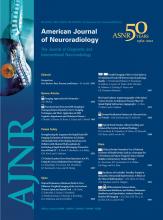Research ArticleBrain
Optimizing MR Imaging Detection of Type 2 Focal Cortical Dysplasia: Best Criteria for Clinical Practice
C. Mellerio, M.-A. Labeyrie, F. Chassoux, C. Daumas-Duport, E. Landre, B. Turak, F.-X. Roux, J.-F. Meder, B. Devaux and C. Oppenheim
American Journal of Neuroradiology November 2012, 33 (10) 1932-1938; DOI: https://doi.org/10.3174/ajnr.A3081
C. Mellerio
aFrom the Departments of Neuroimaging (C.M., M.-A.L., J.-F.M., C.O.)
dUniversité Paris Descartes (C.M., M.-A.L., F.C., J.-F.M., C.O.), Paris, France.
M.-A. Labeyrie
aFrom the Departments of Neuroimaging (C.M., M.-A.L., J.-F.M., C.O.)
dUniversité Paris Descartes (C.M., M.-A.L., F.C., J.-F.M., C.O.), Paris, France.
F. Chassoux
bNeurosurgery (F.C., E.L., B.T., F.-X.R., B.D.)
dUniversité Paris Descartes (C.M., M.-A.L., F.C., J.-F.M., C.O.), Paris, France.
C. Daumas-Duport
cNeuropathology (C.D.-D.), Centre Hospitalier Sainte-Anne, Paris, France
E. Landre
bNeurosurgery (F.C., E.L., B.T., F.-X.R., B.D.)
B. Turak
bNeurosurgery (F.C., E.L., B.T., F.-X.R., B.D.)
F.-X. Roux
bNeurosurgery (F.C., E.L., B.T., F.-X.R., B.D.)
J.-F. Meder
aFrom the Departments of Neuroimaging (C.M., M.-A.L., J.-F.M., C.O.)
dUniversité Paris Descartes (C.M., M.-A.L., F.C., J.-F.M., C.O.), Paris, France.
B. Devaux
bNeurosurgery (F.C., E.L., B.T., F.-X.R., B.D.)
C. Oppenheim
aFrom the Departments of Neuroimaging (C.M., M.-A.L., J.-F.M., C.O.)
dUniversité Paris Descartes (C.M., M.-A.L., F.C., J.-F.M., C.O.), Paris, France.

References
- 1.↵
- Blumcke I,
- Thom M,
- Aronica E,
- et al
- 2.↵
- Palmini A,
- Najm I,
- Avanzini G,
- et al
- 3.↵
- Lerner JT,
- Salamon N,
- Hauptman JS,
- et al
- 4.↵
- Kim DW,
- Lee SK,
- Chu K,
- et al
- 5.↵
- Chassoux F,
- Devaux B,
- Landre E,
- et al
- 6.↵
- Krsek P,
- Maton B,
- Jayakar P,
- et al
- 7.↵
- Urbach H,
- Scheffler B,
- Heinrichsmeier T,
- et al
- 8.↵
- Tassi L,
- Colombo N,
- Garbelli R,
- et al
- 9.↵
- Jeha LE,
- Najm I,
- Bingaman W,
- et al
- 10.↵
- Salamon N,
- Kung J,
- Shaw SJ,
- et al
- 11.↵
- Widdess-Walsh P,
- Diehl B,
- Najm I
- 12.↵
- Chassoux F,
- Rodrigo S,
- Semah F,
- et al
- 13.↵
- Widjaja E,
- Nilsson D,
- Blaser S,
- et al
- 14.↵
- Widdess-Walsh P,
- Kellinghaus C,
- Jeha L,
- et al
- 15.↵
- Colombo N,
- Citterio A,
- Galli C,
- et al
- 16.↵
- Chan S,
- Chin SS,
- Nordli DR,
- et al
- 17.↵
- Kuzniecky R,
- Morawetz R,
- Faught E,
- et al
- 18.↵
- Lee SK,
- Choe G,
- Hong KS,
- et al
- 19.↵
- Mackay MT,
- Becker LE,
- Chuang SH,
- et al
- 20.↵
- Bernasconi A,
- Antel SB,
- Collins DL,
- et al
- 21.↵
- Colombo N,
- Tassi L,
- Galli C,
- et al
- 22.↵
- Barkovich AJ,
- Kuzniecky RI,
- Bollen AW,
- et al
- 23.↵
- Duncan JS
- 24.↵
- 25.↵
- Colombo N,
- Salamon N,
- Raybaud C,
- et al
- 26.↵
- Besson P,
- Andermann F,
- Dubeau F,
- et al
- 27.↵
- 28.↵
- Widjaja E,
- Otsubo H,
- Raybaud C,
- et al
- 29.↵
- Bronen RA,
- Spencer DD,
- Fulbright RK
- 30.↵
- 31.↵
- McGonigal A,
- Bartolomei F,
- Regis J,
- et al
- 32.↵
- Chapman K,
- Wyllie E,
- Najm I,
- et al
- 33.↵
- Bernasconi A,
- Bernasconi N,
- Bernhardt BC,
- et al
- 34.↵
- Wagner J,
- Weber B,
- Urbach H,
- et al
- 35.↵
- Knake S,
- Triantafyllou C,
- Wald LL,
- et al
In this issue
Advertisement
C. Mellerio, M.-A. Labeyrie, F. Chassoux, C. Daumas-Duport, E. Landre, B. Turak, F.-X. Roux, J.-F. Meder, B. Devaux, C. Oppenheim
Optimizing MR Imaging Detection of Type 2 Focal Cortical Dysplasia: Best Criteria for Clinical Practice
American Journal of Neuroradiology Nov 2012, 33 (10) 1932-1938; DOI: 10.3174/ajnr.A3081
0 Responses
Optimizing MR Imaging Detection of Type 2 Focal Cortical Dysplasia: Best Criteria for Clinical Practice
C. Mellerio, M.-A. Labeyrie, F. Chassoux, C. Daumas-Duport, E. Landre, B. Turak, F.-X. Roux, J.-F. Meder, B. Devaux, C. Oppenheim
American Journal of Neuroradiology Nov 2012, 33 (10) 1932-1938; DOI: 10.3174/ajnr.A3081
Jump to section
Related Articles
- No related articles found.
Cited By...
- Benefits and Risks of Epilepsy Surgery in Patients With Focal Cortical Dysplasia Type 2 in the Central Region
- One-Stage, Limited-Resection Epilepsy Surgery for Bottom-of-Sulcus Dysplasia
- Optimizing the Detection of Subtle Insular Lesions on MRI When Insular Epilepsy Is Suspected
- Radiologic and Pathologic Features of the Transmantle Sign in Focal Cortical Dysplasia: The T1 Signal Is Useful for Differentiating Subtypes
This article has not yet been cited by articles in journals that are participating in Crossref Cited-by Linking.
More in this TOC Section
Similar Articles
Advertisement











